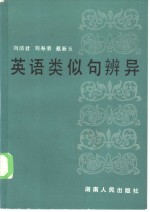

英语类似句辨异PDF电子书下载
- 电子书积分:11 积分如何计算积分?
- 作 者:刘洁君等编著
- 出 版 社:长沙:湖南人民出版社
- 出版年份:1984
- ISBN:9109·63
- 页数:266 页
一、名词和冠词 1
1.summer和winter表示年龄的用法 1
目录 1
2.person和man的用法 5
3.—4.冠词a/an和the表示类别的用法 7
5.—6.复数名词前加the和不加the的用法 8
7.a/an+单数名词和复数名词表示泛指的用法 10
8.“I have a cold”和“I have taken cold”的用法 11
9.have dictation和have a dictation的用法 12
10.since liberation和since the liberation的用法 12
11.you和you all的用法 13
二、代词 13
12.“it is I”和“it is me”的用法 14
13.as tall as I和as tall as me的用法 15
14.all和every的用法 16
15.—16.指代不定代词的人称代词和物主代词的用法 19
17.指代“each+名词”的代词的用法 21
18.指代名词的one和that的用法 22
19.several和a few的用法 25
20.相互代词each other和one another的用法 27
21.who/whom和which指代人的用法 28
22.—23.who/whom的用法 29
24.that和as指代句子的用法 31
25.the same…as和the same…that的用法 33
三、动词 35
(一)动词的时态和语态 35
26.—30.现在一般时和现在进行时表示现在的用法 35
31.—33.过去一般时和现在完成时的用法比较 42
34.I hear that和I have heard that的用法 44
35.—36.过去一般时和过去进行时的用法比较 45
37.—39.带ago和since的句子的动词时态的用法 47
40.—41.现在一般时、将来一般时和现在进行时表示将来的用法 49
42.现在进行时和将来进行时表示将来的用法 51
43.将来一般时和将来进行时表示将来的用法 52
44.将来一般时和将来完成时表示将来的用法 54
45.—46.shall和be going to表示将来的用法 55
47.be going to和be about to表示将来的用法 58
48.be going to和be sure to表示将来的用法 59
49.时间从句使用将来时的结构 60
50.现在完成进行时和现在完成时表示行为持续的用法 60
51.—52.表示应该(或打算)进行而未进行的行为的句型 63
53.表示行为先后发生用过去一般时代替过去完成时的用法 65
54.—55.if条件从句的谓语动词的时态 67
56.it is necessary that从句的谓语动词形式 69
57.时态呼应规则的例外情况 71
58.this book was written by和this book is written by的区别 72
59.—60.用主动语态表示被动意义的结构 73
61.—62.短语动词的用法 75
(二)系动词和助动词 78
63.普通动词作系动词用的用法 78
64.be的缩写形式和全写形式的用法 80
65.—68.shall/should和will/wculd用法的比较 81
69.can和may表示“允诺”的用法 88
70.—71.may/might和maybe表示可能性的用法 89
72.—74.can和be able to的用法 91
75.must,have to/have got to和need(to)的用法 95
76.need作情态动词和普通动词的用法 100
77.dare作情态动词和普通动词的用法 103
(三)动词不定式、动名词和分词 106
78.in order to和so as to+动词不定式的用法 106
79.“with a view to+动名词”和动词不定式的用法 108
80.动词help后接带to或不带to的动词不定式的用法 109
81.作定语用的动词不定式后加介词的结构 110
82.动词stop后跟动名词和动词不定式的用法 111
83.动名词的逻辑主语的形式 112
84.动词不定式和现在分词作宾语补足语的区别 114
85.—87.动名词和动词不定式作宾语的区别 115
88.分词短语代替原因从句的结构 120
89.分词短语代替定语从句的结构 121
90.动词不定式短语代替定语从句的结构 122
91.too+形容词+to+动词不定式代替so+形容词+that从句的结构 123
92.复合宾语代替宾语从句的结构 124
四、形容词和副词 126
93.all和the whole的用法 126
94.be ignorant of和do not know及类似的结构的用法 127
95.better/worse…than和superior to/inferior to的用法 128
96.both和either的用法 129
97.both和two的用法 130
98.Chinese和of China的用法 131
99.few和a few的用法 132
100.I'm glad和I rejoice that的用法 133
101.less…than和not so…as的用法 134
102.many和many a的用法 135
103.not much和little/a little的用法 135
104.not so…as和not as…as的用法 136
105.“there are some pencils in the box”和“there are pencils in the box”的区别 137
106.the shorter of(two)和the shortest of(two)的用法 139
107.also和too作“也”解释时的用法 139
108.loud和loudly及类似的同根副词的用法 141
109.needs must和must needs的用法 143
111.so和such(a/an)的用法 144
110.no more than和not more than的用法 144
112.very和only too/but too/all too的用法 146
113.still和yet两个副词作“仍然”解释含义上的区别 147
五、介词 150
114.according to和in accordance with的用法 150
115.beside和by表示地点的用法 151
116.died of和died from的用法 152
117.differ from和differ with的用法 154
118.have been in和have been to的用法 154
119.leave for和go to的用法 155
120.in和at表示地点的用法 156
121.in,on和to表示方位的用法 158
122.—123.in,of和out of表示物品的材料的用法 160
124.in front of和in the front of的用法 161
125.表示把书翻到第几页的介词用to还是用at的问题 162
126.the need of和the need for的用法 164
127.at night,by night和in the night的用法 165
128.与过去时连用的时间介词in和after的用法 167
129.towards和by表示时间的用法 168
130.英语年、月、日的表示法 169
131.today week和this day week的用法 171
132.this Sunday和next Sunday的用法 172
134.物体长、宽、高等的表示法 173
133.my watch says和by my watch的用法 173
六、连接词 175
135.as soon as,no sooner…than和hardly/scarcely…when的用法 175
136.as well as和not only…but(also)的用法 178
137.because和as表示原因的用法 181
138.as和so连接表示因果关系的句子的用法 181
139.—140.either…or和neither…nor的用法 182
141.if…not和unless的用法 185
142.If和whether表示疑问的用法 186
143.用and连接的并列句表示if条件句意思的结构 190
144.if条件句与定语从句同义的结构 191
145.not…till/until和not…before的用法 193
146.not until,it was not till…that和not…till的用法 195
147.such as,such…as和like的用法 195
148.—149.though,as和however表示让步的用法 197
150.although和may…not的用法 199
151.用when从句和用at the age of短语表示年龄的用法 200
七、否定句的结构 202
152.all…is/are not…表示部分否定的结构 202
153.—154.not any/not a/no和none表示否定的用法 203
155.have的否定式have no/have not any/do not have的用法 206
156.never和not表示否定的用法 208
157.that…not和but表示否定的结构 209
158.to say nothing of和still less的用法 210
159.cannot help+动名词和“cannot but+动词不定式”的用法 212
160.can't/cannot和can not的区别 213
161.I can't seem to和I seem(to be)unable to的用法 214
162.do/did not和don't/didn't的区别 215
163.know的否定式know not/do not know的用法 215
164.“it is no use”和“it is of no use”的结构 216
165.“nor do I”,“neither do I”和“nor I either”的用法 217
八、疑问句 221
166.用any和不用any表示疑问的区别 221
167.—169.用how,what和what…like表示疑问的区别 221
170.用some表示疑问的含义 224
171.“What will you do?”和“What are you going to do?”的区别 226
172.“Will you…?”和“Shall you…?”的区别 227
173.“Would you like…?”和“Do you feel like…?”的用法 228
174.“Who did you see?”“Whom did you see?”和“You saw whom?”的用法 229
九、祈使句 231
175.常用的表示祝愿的祈使句的结构 231
176.命令句中加主语you的结构 232
177.“I beg your pardon”和“Excuse me”的用法 233
178.“Excuse me”和“I am sorry”的用法 233
179.let's和let us的用法 235
180.“May I…?”和“Might I…?”表示请求的用法 237
182.“Would you please…?”“Please…?”“Would you be kind cnough…?”和“Would you mind…?”表示请求的用法 238
181.“Would you…?”和“Will you…?”表示请求的用法 238
十、词序 240
183.间接宾语和直接宾语在句中的位置 240
184.all在句中的位置 242
185.both在句中的位置 243
186.enough在句中的位置 245
187.often在句中的位置 246
188.副词still在句中的位置 247
189.时间状语的排列顺序 249
190.宾语和宾语补足语在句中的次序 249
191.短语动词的宾语在句中的位置 250
192.原因连接词as在从句中的位置 252
193.it seemed在句中的位置 253
194.“it was so hot that I couldn't sleep”和“I couldn't sleep,it was so hot”句型的用法 254
十一、主语和谓语的一致关系 255
195.—196.复数主语用单数谓语的结构 255
十二、表示强调意义的结构 257
197.表示强调的词itself,all,extremely和very的用法 257
198.very well和and that very well的用法 258
199.“it is/was…that”和very表示强调的结构 259
十三、与there be同义的句型 262
200.have和there be表示“存在”的用法 262
201.用we have和there be描述天气的结构 263
- 《从业提醒 预拌混凝土质量事故100例》孙继成著 2012
- 《手斧男孩 首部曲》(美)柏森著 2013
- 《图说食物热量与运动健康》沙怡梅编著 2013
- 《蓝色响尾蛇》孙了红著 2013
- 《疑似预防接种严重异常反应排查方法与实例》卓家同主编 2013
- 《血纸人》孙了红著 2013
- 《深海特征恋人》安晴著 2011
- 《癫痫面面观 健康与理解》(美)英格兰主编;李世卓译 2013
- 《Illustrator CS3中文版课程设计案例精编》张勇毅,封超,张晓伟等编著 2013
- 《走过那一季的春暖花开》一路开花著 2013
- 《市政工程基础》杨岚编著 2009
- 《家畜百宝 猪、牛、羊、鸡的综合利用》山西省商业厅组织技术处编著 1959
- 《《道德经》200句》崇贤书院编著 2018
- 《高级英语阅读与听说教程》刘秀梅编著 2019
- 《计算机网络与通信基础》谢雨飞,田启川编著 2019
- 《看图自学吉他弹唱教程》陈飞编著 2019
- 《法语词汇认知联想记忆法》刘莲编著 2020
- 《培智学校义务教育实验教科书教师教学用书 生活适应 二年级 上》人民教育出版社,课程教材研究所,特殊教育课程教材研究中心编著 2019
- 《国家社科基金项目申报规范 技巧与案例 第3版 2020》文传浩,夏宇编著 2019
- 《流体力学》张扬军,彭杰,诸葛伟林编著 2019
- 《办好人民满意的教育 全国教育满意度调查报告》(中国)中国教育科学研究院 2019
- 《人民院士》吴娜著 2019
- 《中国人民的心》杨朔著;夕琳编 2019
- 《中华人民共和国成立70周年优秀文学作品精选 短篇小说卷 上 全2册》贺邵俊主编 2019
- 《中华人民共和国成立70周年优秀文学作品精选 中篇小说卷 下 全3册》洪治纲主编 2019
- 《中华人民共和国药典中成药薄层色谱彩色图集》(中国)国家药典委员会 2019
- 《北京人民艺术剧院剧本系列 白露》刘国华,马鹏程 2019
- 《中华人民共和国成立70周年优秀文学作品精选 中篇小说卷 上 全3册》洪治纲主编 2019
- 《中华人民共和国国歌 钢琴谱》聂耳编 2019
- 《湖南考古辑刊》湖南省文物考古研究所 2019
